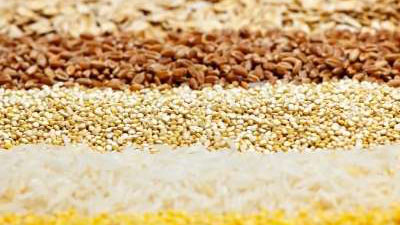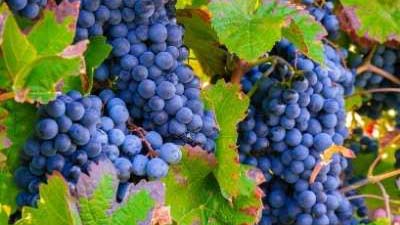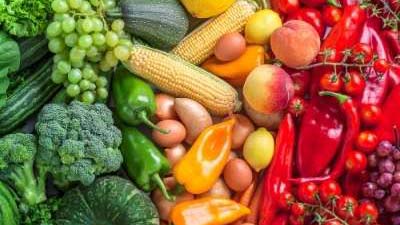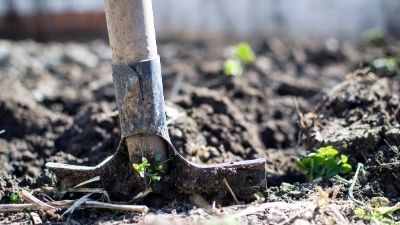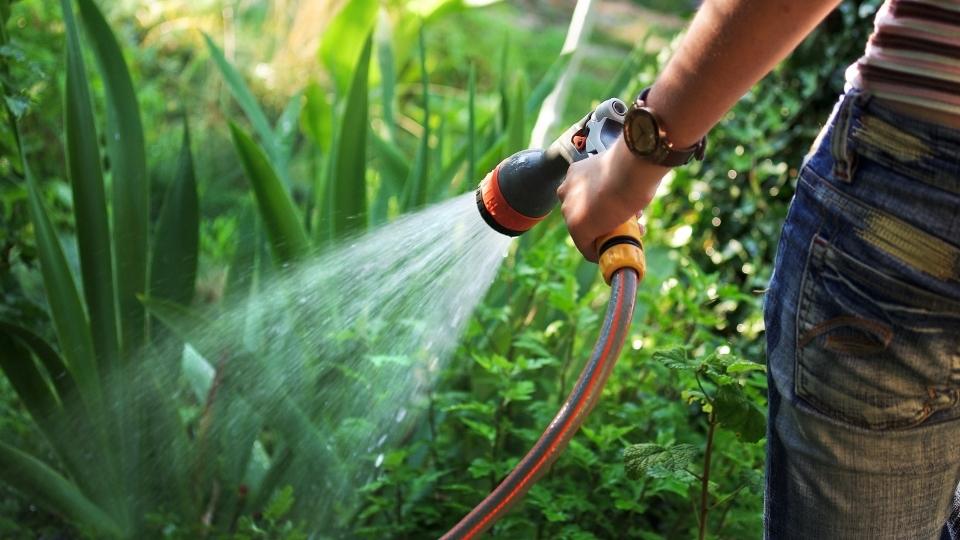Raised Bed Gardening
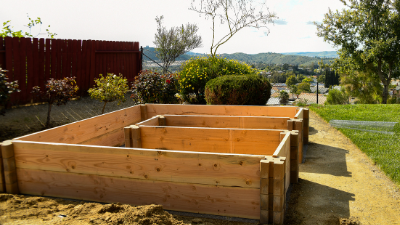
There are many reasons to choose a raised bed garden over a traditional in-ground garden. Some soil conditions are unacceptable for productive plant growth. A gardener might choose to construct a raised bed garden in order to by-pass non-amended or other problem soils. A raised bed garden may benefit areas that have high soluble salts, heavy metals or other contaminates, or clay dominated soil types.
In other cases, a gardener may be limited to a very small growing area. The raised bed method is an efficient way to grow more in less space. Raised beds allow trailing crops like squash and cucumbers to “spill” over the sides of the garden box. Vertical structures can be incorporated to allow vine-type crops like pole beans and peas to climb, making more efficient use of space.
Most gardeners find raised beds are easier to care for than in-ground gardens. Weeding can be accomplished in a matter of minutes by walking around the sides of the bed. Raised beds can be designed to eliminate the need to kneel, making the garden physically easier to work and maintain. Raised beds can also alleviate soil compaction issues because the soil is rarely walked on.
The following points should be considered before building a raised bed garden:
- Raised beds can be either framed or unframed.
- The location should have at least 6 to 8 hours of direct daily sunlight for maximum fruit and foliage production.
- Compost-enriched topsoil or a soilless growing mix can be used to fill the beds. Organic matter tilled into native soil can increase the potential rooting depth of garden plants.
- If the raised bed will be placed where turfgrass once grew, make certain to kill the grass first
- A raised bed garden must be irrigated. Drip irrigation is a simple and efficient method that is perfectly suited for this method.
- Raised bed garden soils warm more quickly in the spring, allowing for earlier planting. However, higher soil temperatures will increase evaporative moisture loss, requiring more frequent irrigation during the hot summer months.
Soil Preparation
A raised bed garden is built on top of the surrounding soil. It can be filled with either a compost-enriched soil mixture or a soilless growing mix. Native soil or topsoil that has been amended with organic matter contains valuable minerals, encourages beneficial microorganism activity, improves soil aeration and drainage, provides excellent plant support, and improves the nutrient and water-holding capacity of the soil.
All soil types benefit from soil amendment. If using existing soil, amend the native topsoil with 30-50% (by volume) well composted organic matter. Composting organic refuse such as animal manures, kitchen scraps, finely ground wood shavings, leaves, and/or grass clippings is an economical way to produce valuable soil amendments in your own backyard. For more information on composting, see the USU Extension fact sheet Backyard Composting In Utah.
Soilless garden mixes are another alternative. These are typically expensive and may become nutrient deficient over time. The benefit of these products is that they are loose, friable in texture, provide good drainage, and retain soil moisture.
Another option is to create your own garden soil mix. A garden soil blend could consists of equal parts (1:1:1 by volume), of the following ingredients:
- Composted Organic Matter: animal manures, composted kitchen scraps, finely ground wood shavings, leaves, grass clippings, and/or peat moss
- Drainage Increasing Materials: coarse-grained sand (no finer than builder’s sand), vermiculite, pumice, or perlite
- Native soil or topsoil
If the organic matter is not fully composted, apply nitrogen to expedite decomposition of the high-carbon organic matter. In general, for every 1 inch of added woody organic material, incorporate ¼ pound of actual nitrogen per 100 square feet of garden area. Actual nitrogen is not equal to the weight of fertilizer. For example, ammonium sulfate (21-0-0) and urea (46-0-0) contain different amounts of actual nitrogen.
Ammonium sulfate (21-0-0) is 21% actual nitrogen or provides 21 pounds of actual nitrogen per 100 pound bag of fertilizer. Urea (46-0-0) is 46% actual nitrogen and contains approximately double the actual nitrogen as compared to ammonium sulfate. Blood meal (12-2-1) is 12% actual nitrogen and contains approximately half the actual nitrogen as compared to ammonium sulfate. See Table 1 for amounts of fertilizer (in pounds) needed for efficient decomposition of non-composted high-carbon organic matter mixed with garden soil.
| Table 1: Fertilizer Application (lbs.) | |
|---|---|
| Nitrogen Fertilizer | Amount per 100 sq. ft. |
| Ammonium Sulfate (21-0-0) | 5 lbs |
| Urea (46-0-0) | 2 lbs |
| Blood Meal (12-2-1) | 8 lbs |
Because soils vary in mineral and nutrient make-up, it is always best to have your garden soil tested in order to identify necessary fertilization additions. Contact USU Soil Testing Laboratory or your local County Extension Service for additional information on soil testing.
Unframed Raised Bed Construction
A simple and inexpensive raised bed can be constructed using an unframed method. An unframed raised bed garden can be created by tilling the existing garden soil 6 to 12 inches deep. Then add 2 to 3 inches of organic matter to the area and till it into the soil. If the organic matter is not fully composted, apply nitrogen to help decomposition as directed above.
Create beds that are 8 to 12 inches above the surrounding soil and 3 to 4 feet wide. The length of the beds can vary, but are typically 4 or more feet long. Walkways between the beds should be included to eliminate foot traffic within the planting area. Walkways should be wide enough to accommodate a wheelbarrow. Spread a layer of mulch, such as bark mulch or straw, over the walkways to reduce weed growth and mud problems.
Framed Raised Bed Construction
A framed raised bed can be constructed as a more permanent structure from any non-toxic, rot-resistant, durable material. Lumber, synthetic (composite) lumber, concrete blocks, brick or stone are a few possibilities. Cedar and redwood lumber is naturally rot resistant. Untreated lumber, such as fir, will rot and breaks-down within a few years. Pressure treated lumber is impregnated with copper-based compounds and may be used for raised bed construction; however, a plastic barrier should be placed between the lumber and the soil mix to prevent contaminants leaching into the garden soil. Railroad ties treated with creosote may cause physical damage to plants touching the black, sticky ooze. Line these with a barrier as well. The best material choice should revolve around cost and personal preferences.
The raised bed box should be at least 6 to 12 inches high to accommodate the rooting depth of most vegetables. Raised bed gardens shallower than 12 inches deep should be constructed with no bottom to allow plant roots access to existing soil below the box. Till the soil beneath the box 6 to 12 inches deep prior to adding new garden soil. Raised beds that are 3 to 4 feet wide will ensure easy access from both sides.
Building a Framed Raised Bed
Cut two pieces of lumber the width of the bed and two others the length of the bed. Screw the corners together with 4 inch long decking screws, to make a four-sided box. To reinforce the corners, screw the sides into a wooden block or metal plate placed inside the corner.
Place the box-like frame on the prepared soil and fill with additional soil. Consider adding a top ledge on the raised bed boxes as a sitting bench at the edge of the Garden. Be sure to include walkways between the raised bed areas that are wide enough for a wheelbarrow or a gardener to work around. Spreading a layer of bark mulch over the walkways will help reduce weed growth and mud problems.
Irrigation
Prior to planting, ensure the raised bed garden has a water source and that irrigation water freely drains through the soil, away from the plant rooting zone. Irrigation of raised beds is most efficient when using some form of “drip” or “trickle” irrigation. Irrigation can be accomplished with a simple soaker hose wound throughout the box or a more sophisticated system using drip tubing controlled by a timer. For more information on installing drip irritation, see the USU fact sheet Designing a Basic PVC Home Garden Drip Irrigation System. Sprinkler irrigation is an additional option; however, sprinkler heads are not as water efficient and they water outside the planting box.
Extending the Growing Season
Raised bed gardens can also be equipped with PVC tubing, rebar, or other sturdy material to form an arching support structure above the garden. This structure can be used to secure horticultural grade plastic sheeting over the garden to mimic a mini-greenhouse. The design should include venting capabilities when the inside area becomes excessively hot. Once ambient air temperatures become too hot, the plastic sheet can be replaced with a shade cloth if desired. This structure can optimize growing conditions and extend the growing season. For more information on high tunnel construction or production options, see the USU production horticulture website.
Published February 2012
Utah State University Extension
Peer-reviewed fact sheet
Download PDF
Authors
Rick Heflebower, Washington County Horticulture Agent
Katie Wagner, Salt Lake County Horticulture Agent
JayDee Gunnell, Salt Lake County Horticulture Agent
JoDeane Condrat, Salt Lake County Horticulture Assistant
Related Research












